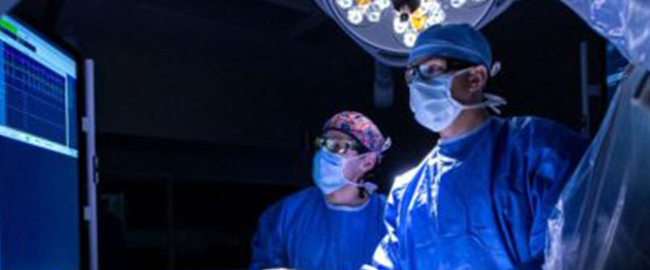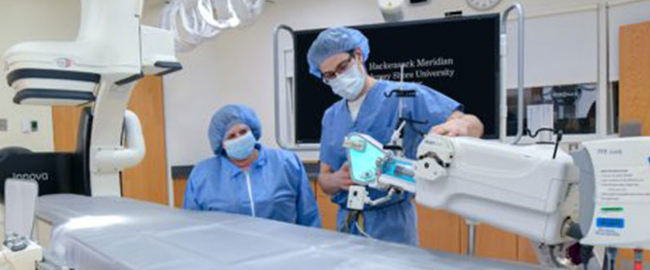What is Cardiac Catheterization?
Cardiac catheterization is a diagnostic tool which enables physicians to identify blockages in the blood vessels (coronary artery) that supply the heart. Additionally, it is used to detect other heart-related diseases such as:
- Congenital heart disease: Defects in one or more heart structures that are present at birth
- Congestive heart failure: A condition where the heart muscle has become too weak to pump efficiently
- Coronary artery disease: When the arteries are clogged by fatty materials in the blood stream
- Valvular heart disease: Malfunction of one or more of the heart valves that can affect blood flow within the heart
Who Is a Candidate for Cardiac Catheterization?
Patients may be referred to an interventional cardiologist for cardiac catheterization if they experience some or all of the following symptoms:
- Chest pain (angina)
- Difficulty breathing
- Dizziness or lightheadedness
- Extreme fatigue
Our Cardiology Specialists

The combination of expert surgeons, advanced technology and array of heart care services makes Hackensack Meridian Health a trusted choice for patients and families in New Jersey.
What to Expect
In cardiac catheterization, a very small hollow tube, or catheter, is advanced from a blood vessel in the groin or arm through the aorta and into the heart. Once the catheter is in place, several diagnostic techniques may be used, including:
- Biopsy: Take blood or tissue samples from inside the heart
- Coronary angiography: Use a contrast dye to show blood flow through the heart and find blockages
- Fractional flow reserve: Measure the pressure and blood flow inside each heart chamber
- Intravascular ultrasound (or IVUS): View inside blood vessels with ultrasound, which uses sound waves
Cardiac catheterization is performed while a patient is awake and they may be asked to take a deep breath, cough or move positions. There is no pain during the procedure as the physician numbs the area where the catheter is inserted, and patients receive medicine to relax.
Once the catheter is in position, the interventional cardiologist can do a variety of tests and in some instances, can treat the condition at the same time.
Treatment capabilities include:
- Angioplasty and stent placements: a small, metal mesh tube called a stent is inserted to open the narrowed or blocked coronary artery.
- Coronary Artery Rotoblator: a long thin catheter is inserted into a coronary artery to “bore out” a narrowing that might not respond to stenting otherwise.
- Pacemaker Implantation: a medical device that uses electrical pulses to regulate your heartbeat
- Cardio Defibrillator Implantation: an implantable device that can help pace the heart and is capable of correcting even the most life-threatening cardiac arrhythmias
- Cardiac Resynchronization Therapy (Biventricular Pacing): this device uses small electrical impulses to make the lower chambers of the heart contract and treat delayed heart contractions that occurs in some patients with advanced heart failure
- Atherectomy: an alternative to angioplasty, this minimally invasive surgery removes atherosclerosis from blood vessels to treat peripheral artery disease
- Thrombectomy: a procedure to remove blood clots from a blood vessel, typically performed in the cerebral arteries
- Valvuloplasty: also known as balloon valvuloplasty, this procedure uses a catheter and small incisions to repair a heart valve with a narrow opening
- Intravascular Ultrasound (IVUS): a diagnostic imaging test that helps with pre-stent planning and post-stent optimization where sound waves are used to see inside blood vessels
- Intra Aortic Balloon Pumps: a mechanical device that consists of a cylindrical balloon placed into the aorta that helps the heart pump blood
- Peripheral Stent Procedures: these procedures consist of an angioplasty or stent placement used to open blocked peripheral arteries
- Carotid Stents: a metal-mesh tube is inserted into the carotid artery and expanded to assist with blood flow in the narrowed carotid artery in the neck
- Electrophysiology Ablations: your physician uses an electrophysiology study and catheter ablation to both evaluate and treat an abnormal heart rhythm
Recovery
Cardiac catheterization usually takes about an hour, and patients rest in the recovery room for a few hours afterward. Most go home the same day, but that may depend on the condition and other factors. Patients can usually return to normal activities within a few days.
If the interventional cardiologist performs angioplasty or another treatment during the procedure, an overnight hospital stay may be required. The care team will provide more details about what to expect before, during and after the procedure.
Why Choose Hackensack Meridian Health for Your Care
National Accreditation

Our Chest Pain Centers are accredited by the American College of Cardiology, recognizing our expertise in diagnosing heart attacks in the earliest stages and quickly performing lifesaving procedures to minimize damage to the heart and blood vessels.
Excellence

Combined, Jersey Shore University Medical Center and Hackensack University Medical Center performed more than 6,700 diagnostic cardiac catheterizations in 2020, and are among the top facilities in the state for elective and primary angioplasty.

Patient Story
“Because I’d never felt that chest pressure before and it didn’t last long, I sort of blew it off,” said Jeffery Wells, Point Pleasant, NJ. Little did he know that listening to his neighbor and wife to seek treatment would lead to an emergency cardiac catheterization that would save his life.
Find a Location for Cardiac Catheterization
Heart Care Services
- Advanced Cardiac Imaging
- Angioscreen
- Atrial Fibrillation
- Cardiac Catheterization
- Cardiac MRI
- Cardiac Rehabilitation
- Cardiac Resynchronization Therapy
- Cardiac Stress Test
- Cardio-Oncology
- Cardiogenic Shock Management
- Coronary Artery Bypass Graft Surgery
- CT Calcium Scoring
- Echocardiogram
- Electrophysiology
- Heart Failure
- HeartFlow Analysis
- Screenings, Prevention and Diagnostics
- Heart Surgery Options
- Hypertension
- Left Ventricular Assist Device (LVAD)
- MitraClip
- Pacemaker Implantation
- Pulmonary Hypertension
- Robotic Heart Surgery
- Structural and Congenital Heart Disease
- TAVR
- TCAR Procedure
- Valve Surgery
- Vascular Care
- Watchman